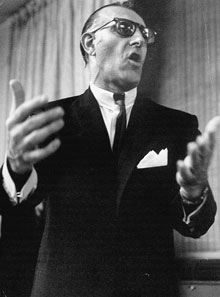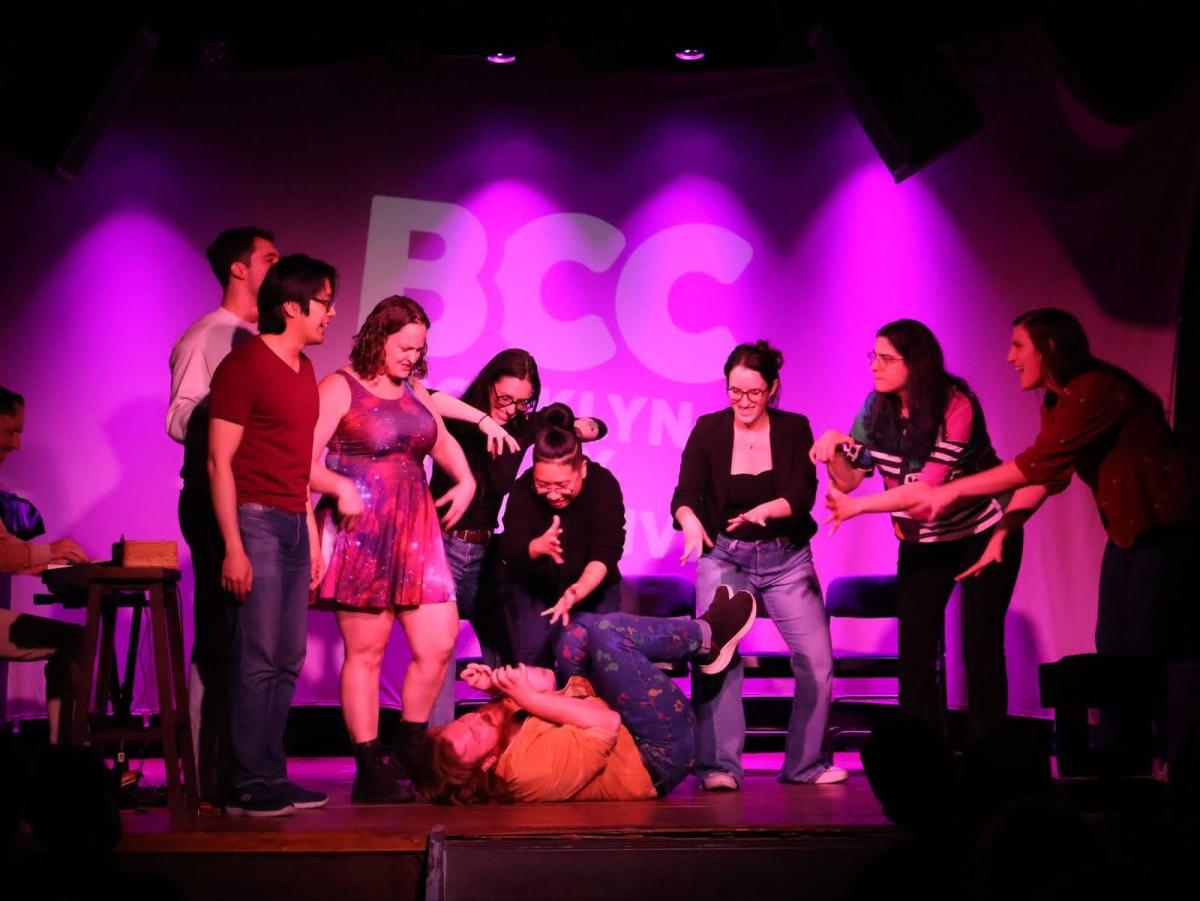By Albert Amateau
Carmine De Sapio, the nearly legendary boss of Tammany Hall, whose political life started as a teenage runner for the Huron Democratic Club in the Village and ended at the age of 61 after a 1969 bribery conviction in Federal Court, died Tuesday evening July 27 in St. Vincent’s Hospital at the age of 95.
The son of Italian immigrants who became prosperous in the South Village (his father, Gerard, owned a fleet of horse-drawn drays), De Sapio’s courtly manners, refined speech and fastidious dress earned him the nickname “The Bishop.”
The first of two sons of Gerard and Marinetta De Sapio, he went to St. Alphonsus parochial school, Fordham Prep and then spent two years at Fordham University. In his late teens he developed iritis, an eye condition that curtailed his studies and caused him to wear dark glasses, which gave him a mysterious, if not sinister, air.
His power at its height as leader of the New York County Democratic Party, commonly known as Tammany Hall, enabled him to handpick candidates like Robert F. Wagner, Jr., who became mayor in 1953 and W. Averell Harriman, who became governor in 1954.
It was a career full of apparent contradictions. De Sapio revived Tammany, which had fallen on bad times, in 1930. He was credited with making party elections more transparent at the same time that he was becoming the party’s undisputed kingmaker.
De Sapio’s first job on the public payroll was secretary to a City Court judge at the age of 29, a patronage position in recognition of his standing in the Huron Club. The same year, 1937, he married Terese Natale, a New Jersey girl he met at a church dance in the Village. The young couple set up housekeeping on Charlton St. His wife died in 1998.
In 1935, De Sapio had challenged the leadership of the Huron Club but lost and formed his own Tamawa Club two years later with headquarters in the heart of the Village at 72 Seventh Ave. He continued his rise to become leader in 1949 of the New York County Democratic Committee. As such, he was the first Italian to lead the traditionally Irish stronghold of Tammany Hall.
His power waned, however, with the shift in Village demographics and the rise of the reform movement in the Democratic party, when dissidents led by Eleanor Roosevelt, former Governor Herbert Lehman and his onetime protégé, Wagner, backed James Lanigan, who defeated De Sapio in the race for Greenwich Village Democratic district leader in 1961. Edward I. Koch, a newcomer to the Village in 1956, who later became mayor, thwarted De Sapio’s return to local power in the district leader primary elections in 1963 and again in 1965.
“He was responsible for putting direct election, instead of indirect election, of the county leader on the ballot. It was a reform measure and it led to his downfall,” recalled Koch, a founder of the Village Independent Democrats club in 1956, a reform club formed to counter the Tamawa Club, which De Sapio founded nearly 20 years earlier to counter the old Huron Club.
“It was easy to get someone to run against a Carmine De Sapio instead of three committee members nobody ever heard of who would then elect a county leader,” Koch explained. Koch recalled that Lanigan left V.I.D. and tried to form a third Village Democratic club, “because he thought the club was too radical.” V.I.D. then picked Koch to oppose De Sapio in 1963 when De Sapio was seeking to win back the district leadership.
“I said I would run if nobody else would and I did. I won by 41 votes,” said Koch recalling that he won again in 1965.
The Villager, which had long supported De Sapio, joined the reform movement effort to oust him from party leadership early on in 1959. A full-page editorial by William Honen, who later joined The New Yorker magazine and then the New York Times, called on Villagers to support V.I.D. candidates against De Sapio’s Tamawa candidates.
“A vast and politically potent group of citizens has decided that something can be done about America’s oldest, most powerful, and certainly most disreputable political machine — Tammany Hall,” the editorial declared.
But for others, De Sapio was himself a reformer, albeit a more conservative version. Rosemary McGrath, a longtime Villager and a Community Board 2 member, recalled being at De Sapio’s headquarters the night in 1961 he lost to Lanigan. “He was a gentleman. He acted the same as he would have if he had won. He went out with class,” she said, adding, “I think he was one of the first leaders to have women and minorities for district leaders.”
De Sapio’s prestige had a dark side, according to “The Last of the Big-Time Bosses, The Life and Times of Carmine De Sapio and the Rise and Fall of Tammany Hall,” by Warren Moscow, a New York Times reporter who became a city official.
The influence of Frank Costello, former bootlegger and a Mafia gambling overlord, was apparent in 1949 and 1950, when De Sapio was at the top of Tammany leadership. Costello acknowledged at a U.S. Senate hearing conducted by Senator Estes Kefauver of Tennessee in 1951 that he had spoken with Tammany leaders and had done them “personal favors.”
De Sapio, however, vigorously denied that Costello had any influence on the Democratic party, but acknowledged attending charitable dinners with Costello. In any case, the Kefauver hearings tarnished New York Republicans as well as Democrats, according to Moscow, who goes on to say in his book that there was no proof that De Sapio had any improper dealings with Costello.
Contributing to the dark-side legend was the 1957 incident of money found in a taxicab. De Sapio had hailed the cab on a July morning a few steps from his apartment on Fifth Ave. at Eighth St. and took it to the Hotel Biltmore in Midtown. After De Sapio left, the driver spotted a white envelope held together with Scotch tape on the back seat. It contained $11,200 in worn and dirty $50 and $100 bills. The driver brought the envelope to a police station and described his last passenger as a tall, well-dressed man wearing dark glasses.
De Sapio acknowledged he had taken the cab but said the money wasn’t his, and maintained that he didn’t notice the envelope when he was in the cab. There was no other claimant and after a year, the money went to the cab driver.
De Sapio’s final downfall came after he had been out of the public eye for about four years.
According to Moscow’s book, De Sapio’s name had been mentioned by a witness in the State Supreme Court bribery trial of James Marcus, Mayor John Lindsay’s Water Supply Commissioner. The case also involved Herbert Itkin, a lawyer, Anthony Corallo, a Mafia-connected loan shark, and Henry Fried, a contractor who was seeking influence to win city contracts to clean a reservoir in the Bronx in addition to city approval for contracts with Con Edison.
De Sapio was indicted on Dec. 28, 1968, in the federal anti-racketeering case, for being a go-between in the conspiracy hatched in Aug. 1967 at a party at Fried’s Germantown, N.Y., horse farm. Marcus had been convicted in the state case for accepting a bribe, and it became a federal case because De Sapio and Itkin went to Fried’s Upstate farm via New Jersey.
Despite De Sapio’s contention that he was not involved with Itkin, Marcus or the Fried contracts, he was convicted on Dec. 13, 1969, for conspiracy — there were no charges of passing money or receiving money. He was sentenced to two years in prison, and the U.S. Court of Appeals upheld the guilty verdict in November 1970. The U.S. Supreme Court declined to review and De Sapio began serving his sentence on June 25, 1971, in the federal penitentiary in Lewisberg, Pa.
James R. McManus, an associate of the McManus & Ahearn Funeral Home in Clinton and a leader of McManus Midtown Democrats, which was founded by his grandfather, is a longtime family friend and was a political ally of De Sapio.
“I was invited to get into that limousine to go with Carmine to Fried’s party at the farm, but I got a call at the last minute that a family friend died and I couldn’t go,” McManus recalled. “If they were going to talk about doing anything wrong, I never would have been invited. I wasn’t in that crowd. Carmine knew my father, Eugene. I was what — 35 years old — a kid,” he said.
McManus said he never lost respect for De Sapio. “He was one of the most astute politicians I ever met in my life. He represented people rather than interests. I became a district leader in 1963 and if I had a problem I’d talk to him. But he didn’t tell me what to do. He’d lay out the whole picture — if I did one thing, something might happen, if I did another thing, something else might happen. I had to make up my mind what to do,” McManus recalled.
“And he was never bitter,” McManus said of his mentor. “All the years that I knew him, I never heard him say one bad word about the people who defeated him. And when he met them he was a gentleman,” McManus said.
De Sapio’s daughter, Geraldine, survives. McManus & Ahern Funeral Home was in charge of arrangements. The funeral was at Sacred Heart Church, E. 33rd St. at Third Ave. on Fri., July 30.
WWW thevillager.com






































